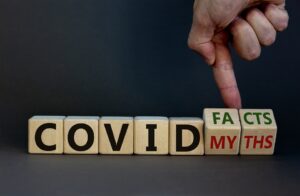
Sometimes it can be hard to separate fact from fiction, especially when so many of the “facts” we’ve spent our whole lives believing are actually enduring myths and misconceptions. These common myths seem true because we’ve heard them time and time again—we may have even learned them from our parents, or been taught them at school. Nevertheless, it’s more important than ever to call out the false facts that far too many people still believe, whether they’re related to our furry friends or the current pandemic. Read on to discover the truth behind some of the most persistent common myths.

Bulls get angry when they see the color red
You’re hardly alone if you believe that when matadors wave those red capes to make bulls charge at them, it’s the bright color that incites their anger. But, according to the American Science Guide, bulls (like other cattle) are red-green colorblind. What actually triggers the bull’s anger is the movement of the cape.

Goldfish only have a three-second memory
Goldfish have a reputation of having bad memories. But it turns out that the idea that these orange aquatic creatures can only remember things for three seconds is a myth. Not only has this false fact been debunked by several studies throughout the years—some research even indicates goldfish could have a memory span of up to five months long.

We only use 10 percent of our brains
Many people believe that humans only use 10 percent of their brains; it’s even the plot line for the 2014 film Lucy, starring Scarlett Johansson. However, that’s nothing but a myth, neurologist Barry Gordon told Scientific American. He says that humans “use virtually every part of the brain” and most of the brain is “active almost all the time.”

George Washington had wooden teeth
It turns out our nation’s first president wasn’t rocking a pair of wooden chompers. The historians at the Washington Library say that while George Washington did suffer from dental problems, his dentures were composed of ivory, gold, lead, and even other human teeth—but never any wood. They believe that this common myth is the result of the ivory becoming stained over time, giving the fake teeth the appearance of wood.

You need to drink at least eight glasses of water every day
If you’re struggling to get to your eighth glass of water every day, don’t feel bad—the quota isn’t really a hard and fast rule for healthy living. According to the Mayo Clinic, the amount of water you need daily depends on several different factors, like your overall health, your activity levels, and where you live. No single number applies to humans across the board—some people may be perfectly hydrated with fewer than eight glasses and others might need more.

In the days of Christopher Columbus, everyone thought the world was flat
Allegedly, around 500 B.C., the Ancient Greek philosopher Pythagoras was the first person to propose the theory that the Earth was flat. But not long thereafter, in the middle of the third century B.C., Aristotle declared with certainty that the Earth was, in fact, spherical. And though it might’ve taken a bit for everyone to come around to the reality that our planet is, well, round, Christopher Columbus wasn’t one of the naysayers. When he sailed the ocean blue in 1492, he knew Earth was a sphere. According to historian Jeffrey Burton Russell, “with extraordinary few exceptions no educated person in the history of Western Civilization from the third century B.C. onward believed that the Earth was flat.”

Adding salt to water makes it boil faster
The difference between boiling water with salt and boiling water without salt is negligible. As Middlebury College chemistry professor Lesley-Ann Giddings explained to LiveScience, “The temperature of saltwater will get hotter faster than that of pure water, but it still has a higher boiling point, and the mass is still greater when you add salt to the same volume of water. This doesn’t mean that the saltwater boils faster.”

Albert Einstein failed math class
If only for the irony of it all, it’s fun to imagine that Albert Einstein was a poor student—so much so, that he failed his grade school math class. But that’s just not true. According to an article in Time, this rumor had spread so widely that it was a topic of a 1935 “Ripley’s Believe it or Not!” column. Einstein himself disputed the article, claiming that he was at the top of his class in primary school. “Before I was 15, I had mastered differential and integral calculus,” he added.

Drinking alcohol raises your body temperature
While you may feel warmer when you drink alcohol, that’s the booze and your brain getting together and playing tricks on the rest of your body. In reality, alcohol actually lowers your core body temperature, according to an oft-cited 2005 study published in the scientific journal Alcohol.

Cracking your knuckles too much will cause arthritis
Knuckle crackers of the world can rest easy, at least on the arthritis front, because, according to Harvard Medical School, cracking your knuckles doesn’t increase your risk of developing the painful joint condition. That cracking noise actually comes from collapsing gas bubbles. However, cracking too often may weaken the strength of your grip (not to mention aggravate the nerves of the people around you).









































































































